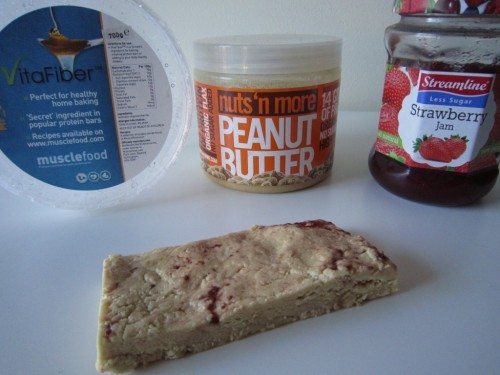Protein bars and nutrition on the go can get costly. Not to mention all the added preservatives and chemicals that go into protein bars and shakes to extend their shelf life. Quest nutrition bars are some of the most popular bars on the market. So I started scouting out some great recipes on how to make your own Quest bars. While there are loads of recipes for quest bars online, if you want them to taste like the original Quest bars, you will have to use their secret ingredient. This special sweetener makes them low glycemic, gluten free and high fiber. VitaFiber isn’t in the U.S. yet, but you can easily order it online from Canada and have your homemade quest protein bars in no time! Here are the top 3 recipes on the web, with the best reviews!
Surprisingly the recipes are pretty simple and all involve 2 very important ingredients, Whey protein (or your own favorite protein powder) and Vita Fiber. I had never heard of VitaFiber so I decided to research the ingredients before ingesting them (naturally).
VitaFiber is a low calorie sweetener that it tons of popular protein shakes and bars. It’s also used like a glue to hold the bar together and keep it from braking apart while eating it. For this recipe, they are using the brand “Muscle Food.” As you would imagine, this ingredients IS loaded with fiber, so don’t go overboard.
VitaFiber™
VitaFiber™ is a sweet natural fiber providing low calorie and soluble prebiotic fiber for human digestive health. VitaFiber™ is non-GMO, sugar-free and gluten-free.
VitaFiber™ is available as a syrup or powder. On a dry basis, VitaFiber™ is greater than 90% soluble fiber. Based on published studies, the caloric value of VitaFiber™ is 2.0kcal/g. All VitaFiber™ products are Kosher and Halal. In addition to being Kosher and Halal, all VitaFiber™ products are FDA GRAS and approved by Health Canada and European Food Safety Authority (EFSA).
Based on scientific studies, VitaFiber™-IMO products are:
- A dietary fiber
- A prebiotic
- Improves overall gastrointestinal health
- A low calorie health sweetener
The following claims are supported by some scientific studies and further studies are in progress:
- Maintain healthy cholesterol levels
- Maintain healthy blood sugar levels
- Has a low Glycemic Index (GI)
- Helps in minerals absorption
- Least flatulence in comparison to inulin and FOS
For more information on VitaFiber™-IMO please click here.
Fitness Tips : In order for the bars to come out accurately. It’s best to weigh the ingrediants using a food scale. You might also want to look at your protein shake container because it will list the grams per scoop. This should give you a good idea of how many scoops of your protein to use. Each container is different and each scooper is different.
Ingredients for Homemade Quest Bars
(image from lowcarbyum.com)
This recipe is for cashew coconut Quest bars.
Makes 4 bars
- 140 grams VitaFiber or other IMO Oligosaccharide Syrup
- 92 grams (4 scoops) natural whey protein powder or any other protein powder. You can also substitute for vegan proteins as well!
- 32 grams (1/4 cup) roasted & lightly salted cashews, finely chopped
- 15 grams (1/4 cup) dried shredded coconut
- 1/2 teaspoon sugar free vanilla extract (source)
Nutrition per bar: 223 calories, 8.5g fat, 61.3mg sodium, 33.3g carbs, 25g fiber, 8.3g net carbs, 19.5g protein
If you want to decrease the amount of carbs per bar, you can reduce or cut in 1/2 the coconut. You can also opt for an all natural, unsweetened coconut.
How to make your own Quest Bars
Step 1
Heat 140 grams of VitaFiber in a small non stick sauce pan over medium heat. Make sure you watch it closely so it doesn’t burn. Heat until it begins to boil. ‘
Step 2
While the VitaFiber is still hot, remove the pan from the heat and quickly add your choice of protein powder and any other ingredient you are using for flavor, such as, peanut butter, jelly, cocoa, vanilla etc. In this case use your cashews, coconut, and vanilla. Mix them together until it begins to take on a dough like consistency. It will also be very sticky.
Step 3
Shape your bars. You can do this on a silicone tray or you can do it on wax paper. It’s best to mold them by hand, just make sure you’ve allowed then to cool long enough so they aren’t overly hot. To solidify the shape of the bar, place them in the fridge for an hour, then transfer them into something that you can use to wrap them. I would suggest putting them in wax paper so you can easily unwrap them later. If you want to keep the moisture in, you can also put them in a Tupperware container and remove them day by day.
Fitness Tips : If you choose not to heat the VitaFiber, your bar will not stick together.
In this particular recipe, the extra additives are the coconut and the cashews. However, there are LOADS of variations. The 2 most important ingredients are your protein and your VitaFiber. Once you have those you can mix and match any other ingredients you like! You could opt for peanuts instead of cashews and add Jam, to make a PB & J bar.

UPDATE: Thank you to everyone who sends me pictures of my recipes on Twitter & Facebook . Please spread the fitness love and keep up the fun posts!
Here’s also a short video that you can use as a visual way to learn. Every recipe is slightly different so test them out and find your favorite.
Homemade Cookie’s and Cream Quest Bars

We want to know your favorite quest bar! Comment on this article! Also, if you have been making your own, share your homemade quest bar recipe with the readers!
Living Lean,
Adria


Leave a Reply